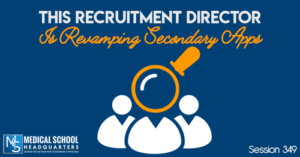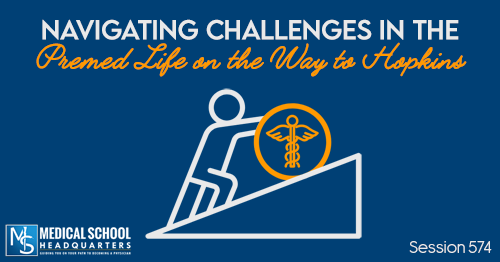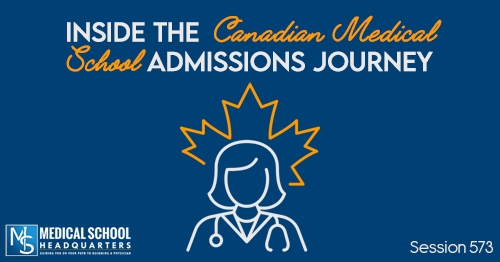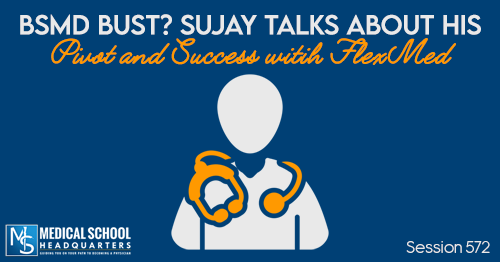Apple Podcasts | Google Podcasts

Session 349
As you’re preparing your applications, it’s important to understand how you as an applicant is looked at by medical schools.
Carle Illinois College of Medicine has no interview and a unique secondary application process. Heather Wright is the Director of Recruitment and she’s here to tell us why.
For more information about Carl Illinois College of Medicine, listen to Episode 256 with Dr. King Li. Find out more about their admissions process and what you need to know before you apply.
Listen to this podcast episode with the player above, or keep reading for the highlights and takeaway points.
[02:49] A Little Background About Heather
As the Director of Recruitment and Student Success, Heather works on helping identify ideal students for the school. And once matriculating, they want to make sure students are happy, healthy, and graduate to become productive, incredible physician innovators.
Within admissions, Heather had the opportunity to develop their secondary application process and offer something that no other medical schools are offering.
[Related episode: 6 Secondary Essay Mistakes and How to Avoid Them]
[03:55] The Problem with Secondary Application
At Carle Illinois, they’re trying to develop a new type of physicians and so they wanted to draw parallels to that in their application process.
Heather explains how a lot of the secondaries right now have gotten away from asking applicants how students are going to be the best fit for the institution.
They want you to write an essay on how to manage stress. And Heather reveals they often get the same answers all the time – whether they love cooking or running. But nothing says about how they’re an ideal fit for a particular medical school.
Heather underlines the importance of asking better questions. They are cognizant and concerned with equity and issues concerning access to medical education. They want to give students the opportunity to show that they’re prepared for medical school in a way that the school can know more about you and see how you’re going to be a fit.
'We wanted to offer a nontraditional secondary application that would be more supportive of people with different experiences.'Click To Tweet[06:15] Why Being a Good Fit Matters
With over 50,000 applications and only a limited number of slots, stats can be the driving force with regard to decision-making, but fit absolutely matters.
The type of environment is very critical in a person’s drive and motivation to succeed. When you’re allowed to do that, it profoundly changes your experience.
This is even more important in medical schools. They want students to be able to offer outstanding patient care and lead a profound mark in healthcare. You have to be in the right environment to do that.
Every applicant should be critically examining what is the culture of that institution. Heather advises that students should be looking at the rate of mistreatment, graduation rate, satisfaction rate – beyond just looking at Step 1 or MCAT score. There is so much more to a medical school that you should be looking at beyond just these quantitative metrics we often look at.
'A good secondary should help you learn more about that institution and see how you will actually fit at that school.'Click To Tweet[08:30] What to Look For in Schools
Many schools would actually withhold some of the information. Or they’d cherrypick information they put out there. Consequently, many programs rely on interviews for you to come and get a preview and talk to the current students.
Heather outlines some of the things to look for when you’re applying to medical school. First, look at their spirit of transparency. Try to get a good feel of the experiences and opportunities students can get engaged with.
Check out their policies relating to student persistence – grading policy, Step1/Step2 policy, etc.
Establish some standardized criteria across schools and this makes it a bit easier.
Moreover, she recommends looking at the secondary essays before adding that school to the primary application. In fact, it’s the first piece of communication you’re receiving from an institution that’s asking about fit.
Start asking yourself about the elements of the school that you enjoy and how is this in line with the type of physician you want to be. What is the environment that will set you up best for success?
'If you matriculate into medical school and it's not the right fit, your next four years are going to be miserable.'Click To TweetMoreover, the burnout rate in medical school can possibly stem all the way back to medical school choice and finding the right fit for medical school.
Heather and I think having a study around this would be interesting and insightful. She adds that your mindset gets shaped by your cohort of peers as you move through your program as well as your interactions with faculty. If that’s a toxic relationship, then you’re pretty disposed to mental health distress as you’re going through residency.
[Related episode: How to Choose a Medical School & Put Together a School List]
[12:15] The Admissions Process in Most Medical Schools
Heather prefaces this by saying that the admissions process would look a bit different at every medical school. Structure is the hard piece.
Also, upon talking with applicants, they expressed how it can be frustrating and heartbreaking to receive secondary application only to find out they were never really considered in the first place. They initially had that hope to advance in the process. In the end, they felt like the schools were only taking their money and were never really considering them.
Unfortunately, this is true for a lot of schools where they establish a minimum cognitive index, which is a combination of your MCAT and GPA.
Based on that output of the calculated score, they determine if you’re eligible for a secondary. For most schools, this will come right back to the admissions process. In general, less than 10 individuals working with the medical school will receive that application. They will do a preliminary scoring of that and make a preliminary recommendation which would then go to faculty who are working on thousands of applications.
'A lot of times, it's computer-driven so it's almost instantaneous that you apply and they kick back a secondary to you.'Click To Tweet[Related episode: NSU-KPCOM Director of Admissions Discusses the Admissions Process]
[14:00] The Admissions Process at Carle Illinois
The admissions process at Carle Illinois is structured very differently. First, they do a competency check because they don’t want to give false hope. They will initially look at your transcript as well as your past experiences.
Have you done research in a lab or have you worked full-time that developed your competence in one particular area? Did you use some free resources (e.g. Coursera, MOOCs) to develop competence?
They ask students to show them how they’ve developed competency for their program.
They have three faculty members that evaluate all of the competence aspects. If they meet their competency threshold, they would then invite them to do the secondary application.
After an applicant receives the secondary application, two faculty members review every application. On average, it takes a faculty member over 45 minutes to score a file.
If there’s a point discrepancy between the two interviewers, this will trigger a reliability review check. A faculty member who is more centralized in the process will do the third review to resolve the point disparity.
'We are really getting to know an applicant through their secondary.'Click To TweetCarle uses all of the content in their AMCAS, memorable experiences, and personal statement. They use the uploaded portfolio as well as their video essay to determine who should be given an offer of admission. (Some schools will also use your interview score or your in-state residency.)
It is a very time-intensive process. At Carle Illinois, they spend time with every piece of information students are sharing with them.
[16:10] No Interviews at Carle Illinois!
Carle Illinois still takes pride in having NO INTERVIEWS. Heather backs this up by talking about an interesting study that came out in Texas. The study found there was no difference between those interviewed students and those who were not.
'In any of the hiring literature, you can see that there's a great deal of bias that comes into play in interviews because it's essentially a social replication theory.'Click To TweetHeather again stresses how interviewing is not a useful tool. They’re not getting data that is actually helping them make a decision. Until they would decide on doing an MMI, which has more evidence to demonstrate it as an effective interview tool, they just don’t believe in adding interviews in their process.
As to why a lot of schools are still not eliminating interview in their process, given the study, Heather explains how these schools have come through a process which they believed it worked for them. Particularly in medicine, where there really has to be this humanistic side, that’s why it’s also an art of medicine, they struggle with this idea of not meeting someone face-to-face.
Heather strongly disagrees with this and this is backed by data. She adds that if they’re telling students that they need to practice evidence-based medicine, then they also need to follow what the social science evidence is showing them.
Interviews are not an effective measure or instrument in the decision-making process. Besides, interviews are so easy to fake it for a day. (Narcissists and sociopaths are great at this!)
All this being said, you really have to think critically about finding better tools to measure this.
[19:00] Other Measurement Tools
There is promise in the situational judgment test that AAMC is trying to develop.
They’re actually creating something that looks like CASPer. The difference is that the situational judgment test looks more to pro social behaviors versus CASPer which is more on negative behaviors.
'Schools are struggling to measure these interpersonal attributes that an applicant has which is why so many schools have gone to CASPer.'Click To TweetHeather explains that they haven’t used CASPer at Carle Illinois for the reason that the faculty struggled to understand how to use the z-score. And she doesn’t think this is fair to the applicant that they don’t get to see their own score. Not to mention that it adds to the financial burden.
Heather points out that faculty struggle with change. If they’re asked too much in the process, there’s fear. Conversely, given the right environment and with faculty really willing to listen to the data, they’re open to trying novel things.
[21:10] Using a Rubric
'In an effort to make the scoring process a little subjective, most medical schools have some flavor of a scoring instrument they're using.'Click To TweetCurrently, Carle Illinois is using a rubric in their scoring system. The experience, attributes, and metrics model that the AAMC put out a few years ago gives some categories of the holistic review that an applicant can look to. They can then see which areas medical schools are likely evaluating you on.
Most institutions have then come up with the scoring instrument that aligns with this model. Faculty can go through this based on your number of publications, volunteer hours, etc. This standardizes that scoring so they can look across applicants to get a better feel for the level of preparation.
The military is also utilizing this in their HPSP students as they apply for a military match. They have rubrics they use in the scoring process as well.
[23:20] Using the Disadvantaged Indicator
Moreover, they also look at how resilient the student is, how curious they’ve been and how they’re making use of their resources.
The secondary is part of the overall admissions score. When someone has described the adversity they’ve come through or their journey to becoming a physician and they’ve done this beautifully on their personal statement, this changes the way admissions read them.
In academic medicine, a paper recently came out called Am I Disadvantaged? that shows how applicants decide when they’re using the disadvantaged status indicator.
What Heather often sees is that she’d be reading beautiful and heartbreaking personal statements. They’re describing true disadvantage but then they’re not using the disadvantaged indicator in their AMCAS.
She then encourages students to look at some of the indicators AAMC has. Read different research and articles that help students in filling out the application.
Heather is a first-gen, low-income individual coming from a rural community consisting of half-Native and half-White. So her identity and experience very much shaped how she picked a major in undergrad and what opportunities worked for her or not.
'Where we come from it does shape us. When we bring that forward in the application, it can offer context to the entire application.'Click To TweetSo when students are able to tie their experiences into their personal statement, this can add context to the entire application. And admissions committees can then do something with it.
[26:20] Consideration for Overcoming Adversity
For instance, Heather had to care for a sick parent previously and this impacted her standing in school. She explains that as an applicant, you can explain this in your application. Talk about the clinical skills you learned at this time. This shows them that you may not have been paid to work as a CNA or medical scribe, but you have learned so much from it with regard to social determinants of health or how to navigate complex healthcare systems.
[27:50] Calling Medical Schools, Utilizing Resources, and Taking SMPs
Moreover, you shouldn’t be afraid of picking up the phone and calling medical schools sometimes. There may be schools that are not as responsive, but there are others that have an open heart and the willingness to talk to students. They want to see applicants become successful.
Tap into advisors at your school, office serving underrepresented students, and listen to podcasts such as this one and other more on the Meded Media network.
Heather also talked with some applicants who called and they believed they had to get a Special Master’s Program (SMP) to get in. This is one of the biggest lies people are developing in medical school admissions.
This has to be a careful decision if you’re going to do this. Consider the factors and what you’re trying to overcome in your application. Heather strongly advises students to call them so they can give proper advice.
Instead of taking an SMP, you might as well get another year of undergrad classes. You can even take community college coursework.
There has been this false narrative that you need to go to this top institution and do this really shiny master’s degree and now you’re going to get in. It’s just not always true.
On the flip side, there are situations that getting an SMP is very helpful. But this is a case-by-case basis that you can’t paint a broad brush with.
Carle Illisnois does its part to somehow spread awareness by going to the national meeting of prehealth advisors every other year. They share this information directly with the advisors. They also do talks with premed students to get the word out so they can also share this information with their social networks.
Many institutions will also do webinars and do direct mailings with pre-health advisors. Ultimately, medical schools have a great responsibility to send out more data.
[33:40] Timeline for Secondary Application and the Rolling Admissions Process
Heather explains that they give applicants a window of time to complete their secondary. They only look at whether they have submitted it on time.
If you’re not going to have enough time to get it done, proactively reach out to those medical schools. Tell them that you need more time.
'Communicating early is key... Proactively versus reactively is critical if you need additional time.'Click To TweetMost schools have a rolling admission process. They timestamp the application as to when it’s 100% done. It then goes out to faculty to review based on that timestamp. Therefore, the earlier you submit your application, the earlier your application is reviewed.
With rolling admissions, where you sit relative to the rest of the pool may be higher if you got it in earlier.
However, Heather has this blanket advice that she gives to students. You are better off to do a nice job on the secondary application and turn it in during the window of time that you have to submit than it is to rush to get it done just to get it timestamped.
Most schools won’t do very much with any update you send to that institution for consideration because the files have already been scored by the admissions. It’s better to take your time and turn in a polished product than to slap something together.
At Carle Illinois, students have two weeks to fill out the competency part of the secondary application. For the remainder of the secondary application, they have four weeks. There’s a countdown clock that runs in their secondary application so they can see how much time they have. For their competency piece, they’ve designed it by providing a drop-down list for the course names.
When a school doesn’t advertise their end date for your secondary, most schools are going to expect to receive it in a month or so. The general rule of thumb that I give to students is to turn them in two weeks due to the rolling admissions.
[41:09] Before You Apply to Carle Illinois: Who Are They Looking For?
Carle Illinois is looking for individuals with a passion for solving really complex problems. They are innovative and can show where their curiosity has taken them and how they’ve demonstrated the spirit for innovation they possess.
'We really want to find physicians who want to rise through the grand challenges in healthcare.'Click To TweetWith the increasing cost and unmet needs existing in healthcare, they’re looking for physicians who can rise through these challenges. They’re looking for learners who have shown passion for creating change in order to transform healthcare.
Part of their admissions requirements is a 498 MCAT. They are serious that they will admit someone with a 498 and up. But that said, they believe in the spirit of transparency. They don’t have a minimum GPA.
What you would see as a standard is a premed coursework track. But they’re also looking for more quantitative competence. This could be things like multivariable calculus, differential equations, and linear algebra. If you don’t have those specific courses, you can substitute them if there’s an overlap.
While they’re an engineering-based college of medicine, it doesn’t mean they only admit engineers. At least a quarter of their class comes from the basic sciences, mathematics, or computer science.
“We’re looking for those people who will be the innovators and game-changers – the people that years from now we'll look back and say medicine is different because of this person.”Click To TweetLinks:
Carle Illinois Before You Apply (with admissions requirements)
PMY Episode 256: A Look at Carle Illinois College of Medicine with Dean Li
Check out the 2020 NAAHP Conference in New Orleans, where Carle Illinois will have a premed day at the event.











